Native American Traditions of Giving Thanks
Air Date: Week of November 20, 2020
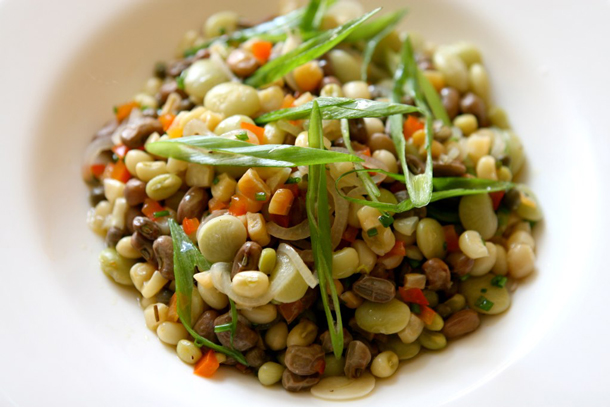
Succotash is a traditional Native American dish consisting of sweet corn, lima beans and other shell beans. (Photo: Susan Lucas Hofman, Flickr CC BY-SA 2.0)
Thanksgiving is a time for many US families and friends to gather and be thankful, but for Native Americans it can also be a reminder of the displacement, violence and disease brought by the white colonists. Joe Bruchac, an author and storyteller of the Nulhegan Abenaki tribe, joined Host Steve Curwood to reflect on Thanksgiving’s complicated legacy for Native Americans and the long Native tradition of giving thanks.
Transcript
CURWOOD: Thanksgiving is one holiday that most Americans feel free to celebrate. No matter what religious or cultural background we come from many of us, in a normal year at least, will gather with friends and family on the fourth Thursday of November to feast on the foods of the harvest season. This year, of course is different, but the spirit of gratitude is still alive during the pandemic. But Thanksgiving is rather more complicated for the people at the center of the Thanksgiving story, Native Americans. There are nearly 600 Native American tribal nations in the US today, each with their own distinct traditions and culture. And to get some insight into some Thanksgiving traditions of the Nulhegan Abenaki tribe of Vermont and upstate New York, we reached out to storyteller and tribal elder Joe Bruchac. Joe, welcome back to Living on Earth!
BRUCHAC: Happy to be here.
CURWOOD: So, Joe, you can tell us what's your feeling generally about the Thanksgiving holiday?
BRUCHAC: I would describe it as ambivalent. It was always very important to when I was a kid growing up but when I looked at it from the viewpoint of Native people, especially here in the Northeast, there is a lot of cultural and historical baggage connected to it, that makes some native people describe it not as a day of Thanksgiving, but a day of mourning. Because of several things, of course, the dispossession of Native people that happened after that, supposed at first Thanksgiving, a number of Native Tribal Nations of the Northeast were either wiped out or driven from their homelands by the very European people who had originally been helped to by them to survive in this new land.
CURWOOD: Yeah, I mean, we're taught in school that Thanksgiving is this holiday framed around the early white settlers, the folks that came to Plymouth, Massachusetts inviting Native Americans to feast as a way of thanking them for their help and learning how to survive in the new world. So how is the holiday taught in your family and your community as you grew up? And how true does that narrative ring to you today?
BRUCHAC: Well, I think the complexity of it is varied. For example, the idea of thanksgiving as a national holiday was first proposed or I should say proclaimed by Abraham Lincoln after the Battle of Gettysburg to celebrate a great victory for the union. Further, in New England, they say the first Thanksgiving that was declared for the Massachusetts colony by John Winthrop, the governor, was after the destruction and the driving out of the Pequod nation. So you can see how there'd be some complexity there.
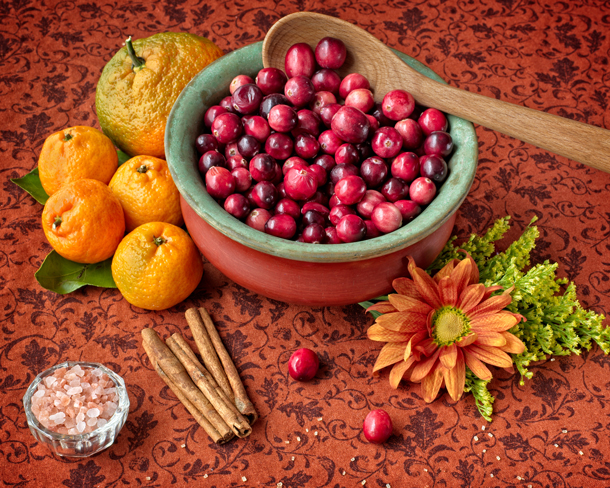
Native Americans ate and used cranberries as a natural dye. Cranberry sauce would not have existed during the first Thanksgiving event since sugar brought by the Mayflower would have already been depleted by November 1621. (Photo: Jim Choate, Flickr, CC BY 2.0)
CURWOOD: Indeed. And of course, it's this time of year that school kids have been learning about Thanksgiving and they maybe made even pilgrim hats and feather headdresses. How do you feel about this way of teaching that part of American history?
BRUCHAC: Well, ironically, the Pilgrim hats they make are not the hats that the pilgrims wore. Okay. And the head dresses, they put on a little circles of paper with feathers sticking up, a lot of Native people feel that it's really not respectful of the way that we dress and it becomes a kind of parody because, as you know, so called ethnic minorities another term I don't particularly like, find themselves often parodied or stereotyped in majority culture. This is an example of, I think, a kind of stereotyping that I'd rather not see.
CURWOOD: So there are a lot of things about the holiday that seemed to have changed over the years, but the foods that generally get set out on the table have remained the same. Of course, there were wild turkeys back then corn was grown squash. To what degree are these types of foods still a part of some Native American cultures?
BRUCHAC: Sure thing, one the favorite dishes of Northeastern Native People is called succotash, which is a mixture of corn, beans and squash, who are called the three sisters of life because they provide and have always provided so much support for our people. And of course, corn and beans and squash are three of the gifts of Native People to the world. Whereas Europeans tended to deal in taming animals and making cows and pigs and horses, none of which were here part of their life in the North American and South American continents they were incredible agronomists, people who did plant breeding and created dozens, in fact, hundreds of varieties of corn and beans and squash.
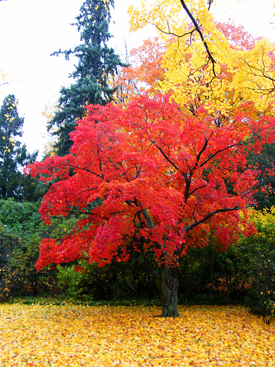
Maple syrup harvesting is a longstanding Native American tradition. A maple tree needs to be forty years old in order to produce sugar maple sap. (Photo: Stanley Zimny, Flickr, CC BY NC 2.0)
CURWOOD: By the way back in those days in the Plymouth area at the coast, what we now call Cape Cod Bay I imagine there were plenty of lobsters. How did that feed into the menu the cuisine of Native Americans and the settlers at that time, do you think?
BRUCHAC: Without a doubt seafood was very important. Fish, crustaceans, such as the lobster, and other creatures from the sea were a very integral part of the diet. In fact, there's some question whether or not there actually was turkey at that first Thanksgiving but there, there certainly was seafood, there certainly, were those vegetables I've mentioned and I'm sure they also brought in deer because venison was a staple for the people at the time.
CURWOOD: Hey, um, tell me about your own family and friends. How do you celebrate Thanksgiving, if at all?
BRUCHAC: Actually, we do. We see it as an opportunity to bring people together to share food and I should point out that within our traditions, here in the northeast, one of the most important things we start with is giving thanks. It's not the idea of Thanksgiving, but the way it's been framed with an American culture that is difficult for Native people. And these Thanksgiving celebrations took place not just at the harvest time in November, but when the maple trees first gave their sap to make maple syrup, when various other plants and harvesting of various types was able to be part of the culture. So, that idea of harvesting and sharing and giving thanks is very deeply ingrained in our traditions. And it's certainly very much a part of my family. Every meal we eat we always begin with a Thanksgiving prayer.
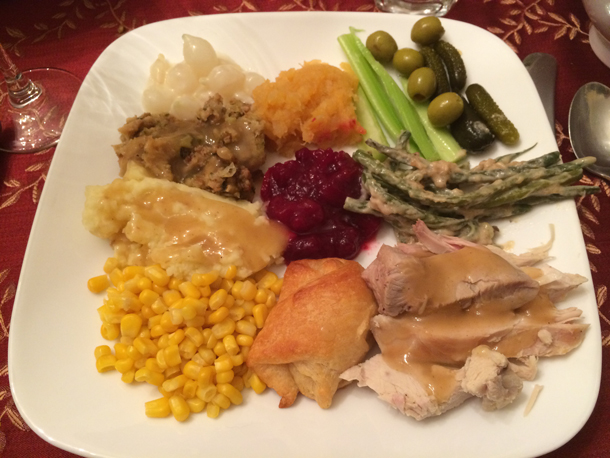
The star of today’s traditional Thanksgiving dinner is usually a large roasted turkey, but it’s unknown if the same dish would have been served during the 1600s. Fish and crustaceans were bountiful at the time and would have formed part of the first Thanksgiving dinner. (Photo: Paulo O, Flickr CC BY 2.0)
CURWOOD: And what is that prayer?
BRUCHAC: We give thanks to the Creator, for the bounty that we've been given. We give thanks to our families, for their health and their good well-being. We give thanks to each other and to the land that sustains us. And, in fact, if you look among our friends slightly to the West, the Haudenosaunee, the Iroquois nations. They say that the Thanksgiving address a very formal enumeration of all the gifts of life from the earth, to the plants, the animals, the winds, the waters, the sun, the moon, the stars, the creator. All of these things must be thanked formally before any important occasion can begin.
CURWOOD: Talking to you, Joe, I realized I should be giving thanks for maple syrup and maple candy. For whatever reason, it escaped me that there's a strong Native American connection to this.
BRUCHAC: And I was told many years ago by Dewasentah, Alice Papineau, the Head Clan Mother, the Onondaga Eel clan, that when we get that first maple sap, it is a medicine given us by the Creator, that if we drink that sap straight from the tree, our bodies are going to be healed from the wounds and the troubles of winter, which I think is a beautiful way to look at it.
CURWOOD: And then traditionally, to what extent do you folks start to boil it down and make it into syrup and then of course the candy it can become?
BRUCHAC: Well, I could describe to some detail the traditional native way of doing it. You cut out Sort of a V in the tree, you put a little hollow piece of sumac there and collected in a bark basket which is watertight. And then you would pour it into a dugout canoe and by heating stones separately and dropping those red hot stones into the canoe full of sap, you'd boil it down and result in maple syrup which then if it was cooked further over a pot, you could turn into candy. In fact, one of the special treats of the wintertime would be to take very hot maple syrup and pour it on the snow which makes it immediately a little kind of candy that you can eat kind of like a snow cone
CURWOOD: And then you wind up with a bunch of sticky canoes?
BRUCHAC: Yeah, you would I guess set up with a sticky canoe although you don't fall out as easily joke, joke.
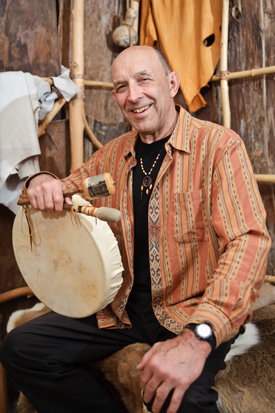
Joseph Bruchac is an author and storyteller from the Nulhegan Abenaki tribe. (Photo: Erik Jenks)
CURWOOD: Well, Joe Bruchac you are an author and a storyteller by trade. I wonder if you have a short story about Thanksgiving or gratitude that you care to share with us at this moment.
BRUCHAC: I think what I'd like to share in fact I know what I like to share something by Tom Porter, who is an elder of the Mohawk Nation, a truly wise person. Tom said that when the world was first created, our Creator told human beings, there was one thing you must do before all others. It is a simple thing: give thanks. Give thanks before you drink water, give thanks to your friends for the things they do for you, give thanks to all of creation and all that you meet. Well, what happened then is it people became forgetful, they stopped giving thanks. And as a result, everything began to go wrong around them. That is when the creator set another messenger and this messenger brought various ceremonies that could be done to remind us of the importance of giving thanks. That is a very simple story. But one I think that is still true to us today. If we forget to give thanks and be grateful indeed, everything begins to go wrong.
CURWOOD: Joe Bruchac is an author, storyteller and elder of the Nulhegan Abenaki Tribe of Vermont and upstate New York. Joe, thanks so much for taking the time with us today.
BRUCHAC: Oh, ,Wliwini Nidôba (thank you my friend in Nulhega) Thank you so much.
Links
Joe Bruchac’s website -- learn more about Joe Bruchac’s stories and work
Living on Earth wants to hear from you!
Living on Earth
62 Calef Highway, Suite 212
Lee, NH 03861
Telephone: 617-287-4121
E-mail: comments@loe.org
Newsletter [Click here]
Donate to Living on Earth!
Living on Earth is an independent media program and relies entirely on contributions from listeners and institutions supporting public service. Please donate now to preserve an independent environmental voice.
NewsletterLiving on Earth offers a weekly delivery of the show's rundown to your mailbox. Sign up for our newsletter today!
 Sailors For The Sea: Be the change you want to sea.
Sailors For The Sea: Be the change you want to sea.
 The Grantham Foundation for the Protection of the Environment: Committed to protecting and improving the health of the global environment.
The Grantham Foundation for the Protection of the Environment: Committed to protecting and improving the health of the global environment.
 Contribute to Living on Earth and receive, as our gift to you, an archival print of one of Mark Seth Lender's extraordinary wildlife photographs. Follow the link to see Mark's current collection of photographs.
Contribute to Living on Earth and receive, as our gift to you, an archival print of one of Mark Seth Lender's extraordinary wildlife photographs. Follow the link to see Mark's current collection of photographs.
 Buy a signed copy of Mark Seth Lender's book Smeagull the Seagull & support Living on Earth
Buy a signed copy of Mark Seth Lender's book Smeagull the Seagull & support Living on Earth

